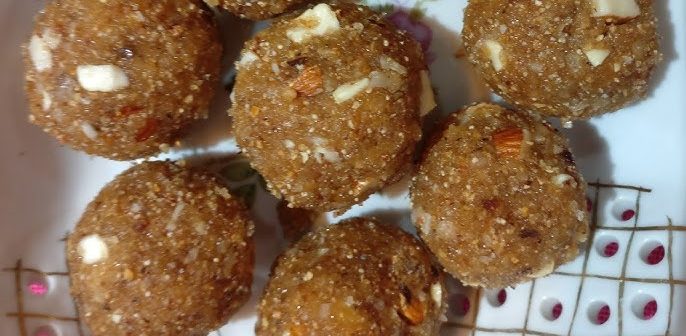Dink Ladoo, a traditional sweet snack from Pune, Maharashtra, holds a special place in the region’s culinary heritage. Known for its nutritional value and energy-boosting properties, this ladoo has become popular among health-conscious individuals as well as those looking for a tasty treat with deep cultural roots. Here’s a comprehensive look at the origin, ingredients, nutritional benefits, and why Dink Ladoo continues to be an essential part of the Maharashtrian diet.
The Origin of Dink Ladoo
Dink Ladoo is a part of the long-standing tradition of Maharashtrian ladoos, typically consumed during festivals and special occasions. It derives its name from “Dink,” the Marathi word for edible gum, which is the key ingredient of this ladoo. The ladoo was originally consumed as a winter snack, believed to provide warmth and energy, making it particularly popular among new mothers, laborers, and those needing an energy boost in colder climates.
Edible gum, extracted from the bark of certain trees, was an easily available resource in ancient India. As Ayurveda and traditional medicine emphasize food’s role in maintaining health, Dink Ladoo naturally became a go-to for its combination of energy and medicinal value.
Ingredients and Nutritional Value
The star ingredient of Dink Ladoo is edible gum (also known as “gond” in Hindi or “dink” in Marathi). This natural gum is known for its properties that help strengthen bones and boost overall energy. It is particularly rich in protein, essential minerals, and fats, making it ideal for consumption by lactating women, children, and people recovering from illness.
Some of the common ingredients in Dink Ladoo include:
- Dink (Edible Gum): Known for enhancing joint health and stamina.
- Wheat flour: Provides carbohydrates for sustained energy.
- Jaggery or Sugar: Natural sweeteners that provide a quick energy boost.
- Dry fruits (Almonds, Cashews, etc.): A source of healthy fats, vitamins, and antioxidants.
- Desi Ghee (Clarified Butter): Rich in fats and helps improve the body’s metabolism and digestion.
- Poppy seeds: Known for their calming properties and packed with calcium.
Each of these ingredients is carefully roasted and combined, ensuring that the final product is nutrient-dense. A single Dink Ladoo is often rich in calories due to its combination of fats and sugars, making it perfect for those looking for an energy-rich snack.
Cultural Significance and Usage
Dink Ladoos are often consumed during the winter months because they provide the warmth required during the cold season. They are a staple in the diet of postpartum women, believed to help with recovery after childbirth by strengthening muscles and joints. In addition, it is common for athletes and laborers to eat Dink Ladoo to replenish their energy after strenuous activity.
In Maharashtrian households, these ladoos are often made in bulk and stored for daily consumption. The recipe is passed down through generations, with each family adding its twist to the ingredients and preparation techniques.
The Popularity of Dink Ladoo in Modern Times
While traditionally made at home, Dink Ladoo has gained commercial popularity in recent years due to its nutritional benefits. It is now widely available in local sweet shops and health stores across Pune and Maharashtra, catering to urban populations looking for healthier snack options.
With the rise of fitness trends and superfoods, Dink Ladoo has found its place as a nutritious alternative to processed snacks. Many health-conscious individuals, particularly those focused on traditional and natural food sources, have embraced Dink Ladoo as part of their diet. The sweet, which is free from artificial additives and preservatives, aligns with the movement toward clean and organic eating.
Facts and Figures
- Market Presence: The demand for traditional sweets like Dink Ladoo has seen a 20-25% increase in Pune and surrounding regions, with an uptick in sales during the winter months and festive seasons.
- Health Benefits: Dink Ladoo is a rich source of calcium, iron, and magnesium, contributing to bone health and immunity. It is particularly popular among pregnant and postpartum women.
- Production Growth: Several local producers have expanded their business, and Dink Ladoo has found a niche market among online retailers, where organic and homemade versions are sold across India.
Steps to Popularize Dink Ladoo Globally
While Dink Ladoo has seen growth in the Indian market, there are steps that can help popularize it globally:
- Nutritional Awareness: Highlighting the health benefits through packaging and marketing can make it attractive to international consumers interested in superfoods.
- Fusion Recipes: Experimenting with modern takes on traditional recipes, such as gluten-free or vegan versions, can appeal to health-conscious consumers worldwide.
- Export Initiatives: With the growing demand for exotic, natural, and organic foods in the West, Dink Ladoo can be marketed as an energy-dense, cultural snack.
Conclusion
Dink Ladoo is not just a sweet treat; it is a reflection of Pune’s rich cultural and culinary history. Its blend of nutritional and medicinal properties makes it a unique snack that has transcended generations. As awareness about traditional superfoods grows, the popularity of Dink Ladoo is likely to increase, both in India and globally. Its versatility, health benefits, and deep-rooted cultural significance ensure that it remains a beloved staple in Maharashtrian cuisine.





